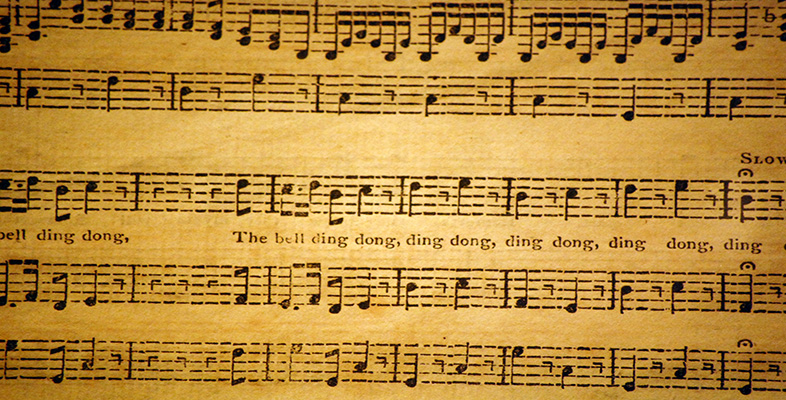3.6 A second reduction: analytical levels
Next I want you to make another foreground reduction, in order to demonstrate how the sorts of analytical observations found at this level always lead on to considerations of issues at deeper levels of the harmony. This next activity, which is based on Mozart's Piano Sonata in B flat, K570, is presented partly on video, in four sections.
Activity 13
Watch the first section of the video
Voice-leading analysis, Mozart Piano Sonata in B flat K570 (part 1, 1 minute)
Transcript: Voice-leading analysis, Mozart Piano Sonata in B flat K570 - Part One
Activity 14
You have been asked to make your own foreground analysis of the first four bars of Mozart's Piano Sonata in B flat, K570, which is shown as Example 15 below. Just as you did with K545, choose the notes in the top and bottom lines which are consonant harmony notes, and write these out on two staves. To do this, you should print out the sheet of music manuscript paper at the link below. To help you, I would suggest that you look for repeating patterns. Note that, as in K545, the rate of harmonic change is not constant. In the first two bars, the harmony changes every crotchet. In the third bar, the rate changes to minims, and in the fourth bar leading up to the imperfect cadence, the rate speeds up to quavers.
Click to open blank staves [Tip: hold Ctrl and click a link to open it in a new tab. (Hide tip)] .
Activity 15
Watch the next clip from the video now, where my solution will be explained, and the analysis will be taken a stage further.
Voice-leading analysis, Mozart Piano Sonata in B flat K570 (part 2, 4 minutes)
Transcript: Voice-leading analysis, Mozart Piano Sonata in B flat K570 - Part Two
Activity 16
Next, compare your solution to Activity 14 with my graph (Example 16). I hope your reduction looked similar to mine, apart from the 10–10–10 (showing interval patterns) and crossing lines (showing voice exchange) which the video has now explained. This completes a foreground analysis of these bars. Notice that, like all musical foregrounds, it makes a good piece of simple counterpoint on its own, with no parallel fifths or octaves. This is why Mozart's harmony makes sense – we have analysed the way he was thinking of the harmonic movement in these bars.
Activity 17
As you watch the next part of the video, you may find it helpful to have Examples 17a–d to hand, which reproduce the next stages of analysis as demonstrated on the video. The examples are labelled ‘Level 1’, ‘Level 2’, ‘Level 3’ and ‘Level 4’. These ‘levels’ will be explained on the video, but before you watch, it might help you to know that they represent a progressive reduction of the notes of the original music. Thus Level 4 gives just the harmony notes, but still including the appoggiaturas, and Level 1 is a simple representation of the basic harmonic structure of the passage. These examples are discussed on the video beginning with Level 4 and working through to Level 1, to show you this process. Continue with the next video clip now.
Voice-leading analysis, Mozart Piano Sonata in B flat K570 (part 3, 5 minutes)
Transcript: Voice-leading analysis, Mozart Piano Sonata in B flat K570 - Part Three
Activity 18
When we start to analyse more deeply than the foreground level of the music, we have to spot those harmonies which are consonant in the music as it is played, but are dissonant at a deeper level – they are passing notes or neighbour notes within the same harmony.
Look at the four levels of the music printed as Examples 17a–d. Put ‘P’ and ‘N’ above the passing notes and neighbour notes in Level 3 that are missing from Level 2, and then do the same with Level 4; that is, put ‘P’ and ‘N’ above the notes that are missing from Level 3. To do this, you should print out Example 17 at the link below.
Click to view pdf of Example 17
Activity 19
When you have marked in the neighbour notes and passing notes, please return to the next video clip to see my solution. This time I work through from Level 1 to Level 4, showing the gradual elaboration from the middleground to the foreground and then to the full score. For your reference, Examples 18a–d reproduce my solution as demonstrated on the video.
Voice Leading Analysis Mozart Piano Sonata in B flat K570 (part 4, 2 minutes)










